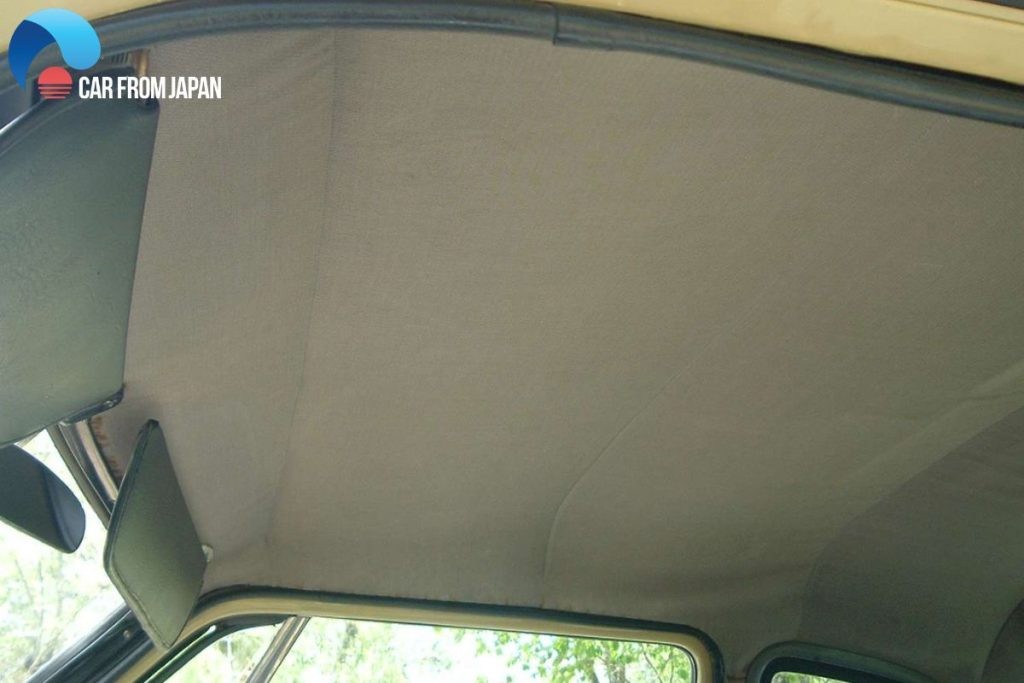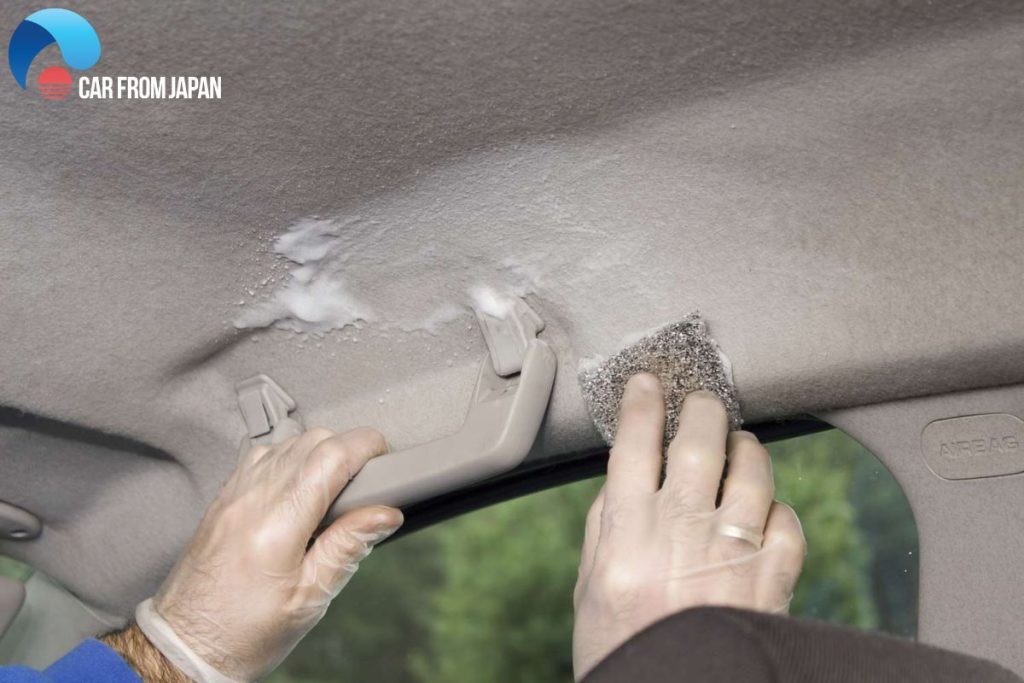A sagging car headliner is more than just an eyesore; it can detract from your driving experience and even indicate underlying issues. If you’re noticing your car’s ceiling fabric drooping, you might be wondering how to restore it without the hassle and expense of a full replacement. This guide will walk you through effective DIY methods to fix your sagging headliner without removing it, saving you time and money. Let’s dive in and learn how to bring your car’s interior back to its former glory.
Understanding Your Car Headliner
The headliner, or car ceiling lining, is the fabric material that covers the interior roof of your vehicle. It’s not just for aesthetics; it plays a crucial role in your car’s comfort and functionality. Typically made of fabric backed with foam, often polyurethane, the headliner is attached to a rigid board that is secured to the car’s roof frame.
This multi-layered construction serves several important purposes:
- Smooth Interior Finish: It provides a clean, finished look to the car’s interior, hiding the structural elements of the roof.
- Noise Absorption: The foam layer helps to dampen road noise and wind noise, making your cabin quieter and more comfortable, especially at higher speeds.
- Temperature Insulation: The headliner acts as an insulator, helping to regulate the temperature inside your car. It keeps the cabin cooler in hot weather and warmer in cold weather by buffering against external temperature extremes.
- Acoustics Enhancement: The headliner material also improves the sound quality within the car, optimizing the performance of your car’s audio system.
A car headliner provides a smooth interior finish and insulation.
Common Causes of Sagging Car Headliners
Over time, you might notice your car headliner starting to sag or droop. This is a common problem, especially in older vehicles, and is often caused by the degradation of the adhesive that bonds the fabric to the headliner board. Several factors can contribute to this breakdown:
1. Heat and Sunlight Exposure:
Excessive heat is a primary culprit behind sagging headliners. When your car is exposed to intense sunlight and high temperatures, especially during hot summer months, the heat can penetrate the roof and cause the adhesive to weaken and break down. This is particularly true for cars parked outdoors for extended periods. The heat essentially melts the glue, causing the fabric to detach from the backing board.
2. Moisture and Humidity:
Moisture is another significant factor that can lead to a sagging headliner. Humidity, leaks from sunroofs or windows, or even condensation can seep into the headliner material. The foam backing is particularly susceptible to absorbing moisture, which can cause it to lose its structural integrity and shape. This moisture weakens the adhesive and can lead to warping, detachment, and ultimately, sagging.
3. Age and Material Degradation:
Like any material, the components of a car headliner, including the fabric, foam, and adhesive, degrade over time. The adhesive can become brittle and lose its bonding strength due to age and exposure to environmental factors. The foam backing can also crumble or deteriorate, further contributing to the sagging issue.
4. Poor Initial Installation:
In some cases, a sagging headliner can be attributed to poor installation during the manufacturing process. If insufficient adhesive was used or improper techniques were employed when the headliner was initially installed, it is more likely to sag prematurely. Substandard waterproofing in some vehicles can also allow moisture to penetrate the roof liner foam from the beginning, accelerating adhesive failure.
5. Physical Stress:
While less common, physical stress can also contribute to a sagging headliner. Activities such as children or pets pulling or scratching at the headliner fabric can put strain on the adhesive and backing board, speeding up the process of deterioration and sagging.
DIY Methods to Fix Sagging Headliner Without Removal
Replacing the entire headliner can be a costly and time-consuming job, often exceeding the value of an older car. Fortunately, there are several effective and budget-friendly methods you can use to repair a sagging headliner without removing it. These techniques are designed to re-adhere the fabric to the backing board, restoring the appearance of your car’s interior.
Simple DIY methods can effectively repair a sagging car headliner.
1. Re-gluing with Headliner Adhesive
For minor sagging, especially in corners or along edges, re-gluing can be a straightforward solution. This method works best when the fabric is only partially detached.
Materials You’ll Need:
- Headliner Adhesive Spray: Specifically designed for automotive headliners, this adhesive is heat-resistant and provides a strong bond. Avoid using general-purpose glues as they may not withstand the temperature fluctuations inside a car and could damage the headliner material.
- Masking Tape: To protect surrounding areas and prevent overspray.
- Cardboard or Newspaper: To further shield the interior from adhesive spray.
- Clean Cloth: For wiping away excess adhesive.
Steps:
- Preparation: Clean the sagging area of the headliner with a soft brush or vacuum cleaner to remove any loose debris or dirt. Protect the surrounding areas, including trim, windows, and seats, with masking tape and cardboard or newspaper.
- Apply Adhesive: Shake the headliner adhesive spray can well. Hold the can about 6-8 inches away from the sagging fabric and apply a light, even coat to both the back of the fabric and the corresponding area on the headliner board. Avoid oversaturating the fabric, as this can cause staining or bleed-through.
- Reattach Fabric: Allow the adhesive to become slightly tacky, as per the product instructions (usually a minute or two). Carefully press the fabric back into place against the headliner board. Work from the center outwards, smoothing out any wrinkles or bubbles.
- Secure and Dry: Use a clean cloth or a small roller to firmly press the fabric against the board and ensure a strong bond. Let the adhesive dry completely according to the manufacturer’s instructions, usually several hours. Keep car windows open for ventilation during drying.
- Remove Masking: Once dry, carefully remove the masking tape and any protective coverings.
2. Using Sequin or Twist Pins
For a quick and inexpensive fix, especially for more significant sagging, pins can be an effective solution. This method is particularly useful when you need immediate results and want to avoid using adhesives.
Materials You’ll Need:
- Sequin Pins or Twist Pins (Headliner Pins): Sequin pins are fine and less visible, while twist pins (also known as upholstery twist pins or saggy stopper pins) have clear or decorative heads and a screw-like design for secure holding power. Choose pins that are long enough to go through the fabric and into the headliner board firmly.
- Optional: Pattern Template: For creating a uniform pin pattern if desired.
Steps:
- Gather Sagging Fabric: Gently gather the sagging fabric and push it back up towards the headliner board.
- Insert Pins: Starting at the most severely sagging areas, push the pins through the fabric and directly into the foam backing board. If using sequin pins, push them straight in. If using twist pins, twist them in for added grip.
- Space Pins Evenly: Space the pins evenly across the sagging area, working outwards. You can arrange them in a pattern (lines, diamonds, etc.) for a more visually appealing finish. Ensure the pins are pushed in firmly enough to hold the fabric in place but not so forcefully that you damage the headliner board.
- Check and Adjust: Step back and check the headliner’s appearance. Add more pins as needed until the sagging is minimized and the fabric is relatively smooth and taut.
3. Clear Headed Twist Pins (Saggy Stoppers)
Clear-headed twist pins, often marketed as “saggy stoppers,” are specifically designed for repairing sagging headliners. They offer a more robust and less visible solution compared to standard pins.
Materials You’ll Need:
- Clear Headed Twist Pins (Saggy Stoppers): These pins have a clear plastic head and a spiral shaft that screws into the headliner board, providing a secure and discreet hold.
Steps:
- Identify Sagging Areas: Locate the areas where the headliner is sagging most noticeably.
- Position and Twist: Hold the sagging fabric against the headliner board and position a twist pin where you want to secure it. Push the pin through the fabric and begin twisting it clockwise into the headliner board.
- Secure Firmly: Continue twisting until the pin is firmly embedded in the board and the fabric is held snugly against the ceiling. The clear head makes the pin less noticeable.
- Repeat as Needed: Repeat steps 2 and 3, spacing the twist pins evenly across the sagging areas until the headliner is properly secured and the sagging is minimized. These pins can be used across the entire headliner if necessary, even for significant sagging.
4. Steam Cleaner and Paint Roller Method
This method uses heat and pressure to reactivate the original adhesive. It’s best suited for situations where the adhesive has weakened but not completely deteriorated, and when the fabric is sagging primarily around the edges.
Materials You’ll Need:
- Steam Cleaner: A handheld garment steamer or a car detailing steam cleaner will work. Ensure it produces a gentle, controlled steam.
- Paint Roller (Soft Foam or Fabric Roller): A clean, soft roller to smooth the fabric.
- Clean Cloths: To wipe away any moisture or excess adhesive.
Steps:
- Prepare the Area: Clean the sagging area of the headliner to remove any dust or loose debris.
- Apply Steam: Using the steam cleaner, gently apply steam to the sagging fabric area. Move the steamer slowly and evenly, holding it a few inches away from the fabric. The steam will help to reactivate the old adhesive. Avoid over-saturating the fabric with steam.
- Roll and Smooth: Immediately after steaming an area, use the paint roller to gently but firmly roll over the fabric, pressing it back against the headliner board. Work in sections, steaming and rolling small areas at a time.
- Dry and Repeat: Allow the area to dry slightly. If necessary, repeat the steaming and rolling process in stubborn areas. Use a clean cloth to absorb any excess moisture.
- Ventilate: Keep car windows open to allow the headliner to dry completely and prevent moisture buildup inside the car.
Preventing Future Headliner Sagging
While these DIY methods can effectively repair a sagging headliner, prevention is always better than cure. Here are some tips to help prolong the life of your car headliner and prevent future sagging:
- Park in the Shade: Whenever possible, park your car in shaded areas or garages, especially during hot and sunny weather. This reduces heat buildup inside the car and minimizes adhesive degradation.
- Use Sunshades: Utilize windshield sunshades and window shades when parking in direct sunlight to further reduce interior heat.
- Regularly Check for Leaks: Inspect your car’s sunroof seals, window seals, and door seals regularly for any signs of leaks. Address any leaks promptly to prevent moisture damage to the headliner.
- Control Interior Humidity: If you live in a humid climate, consider using a car dehumidifier or moisture absorber, especially during periods of high humidity.
- Gentle Cleaning: When cleaning your car’s interior, be gentle around the headliner. Avoid harsh chemicals or excessive moisture. Use a soft brush or vacuum cleaner with a soft brush attachment to remove dust and debris.
- Protect from Physical Stress: Remind children and pets not to pull or scratch at the headliner fabric.
Headliner Replacement Costs: When DIY Isn’t Enough
While DIY repairs are effective for many sagging headliner issues, there are situations where replacement might be necessary. If the headliner is severely damaged, torn, stained, or if the backing board itself is deteriorated, replacement may be the best option.
The cost to replace a car headliner can vary significantly depending on factors like:
- Vehicle Type and Model: Luxury vehicles or those with complex headliner designs (e.g., with sunroofs, moonroofs, or integrated lighting) generally cost more to replace.
- Headliner Material: The type of fabric and foam used can affect the price.
- Labor Costs: Labor rates vary by location and mechanic.
- DIY vs. Professional Installation: DIY kits are cheaper but require time and effort. Professional installation ensures quality but is more expensive.
Estimated Headliner Replacement Costs:
| Vehicle Type | Estimated Cost Range |
|---|---|
| Sedan/Hatchback/Coupe (Simple Design) | $300 – $750 |
| SUV/Crossover (Sunroof/Moonroof) | $500 – $900 |
| Luxury Vehicle (Complex/High-Quality Ceiling) | $1,000 – $6,000+ |


These are just estimates, and actual costs can vary. Getting quotes from local auto upholstery shops or mechanics is recommended for accurate pricing.
Conclusion
A sagging car headliner can be an annoying problem, but it doesn’t have to be a major expense. By using these simple DIY methods, you can effectively repair your sagging headliner without removing it, saving yourself time and money. Whether you choose re-gluing, pins, twist pins, or the steam cleaner method, these techniques offer practical solutions to restore your car’s interior. Remember to also take preventative measures to protect your headliner from future sagging. However, if the damage is extensive, consider professional replacement to ensure a long-lasting and aesthetically pleasing result.
FAQs About Sagging Car Headliners
How do you know if your ceiling is sagging?
Signs of a sagging car ceiling include:
- A cracking or popping sound from the ceiling area, especially when the car moves or doors are closed.
- Visible drooping of the headliner fabric.
- Cracks or blisters appearing in the headliner material.
- The fabric pulling away from the edges or corners of the ceiling.
Is it OK to fix the headliner sagging myself?
Yes, for many common sagging headliner issues, DIY fixes are perfectly acceptable and effective. DIY repair kits and readily available methods like gluing or pinning can address minor to moderate sagging and save you significant costs compared to professional replacement.
Can I paint a headliner?
While technically possible, painting a headliner is generally not recommended. Paint can stiffen the fabric, alter its texture, and may not adhere well long-term due to temperature changes inside the car. The preparation and effort involved in painting are often comparable to or greater than the effort required for replacement, making replacement a more sensible option if you desire a color change or significant aesthetic improvement.
Does car insurance cover the cost of car headliner replacement?
Generally, standard car insurance policies do not cover headliner replacement due to wear and tear or age-related sagging. Car insurance typically covers damage from accidents, vandalism, or natural disasters. Some extended warranties or specific upholstery protection plans might offer coverage, but it’s best to review your policy details to confirm.

